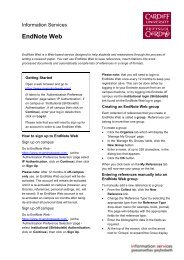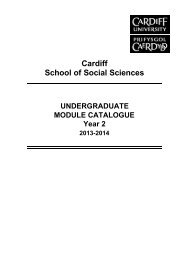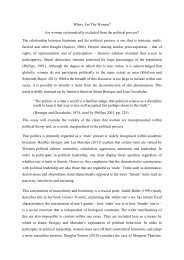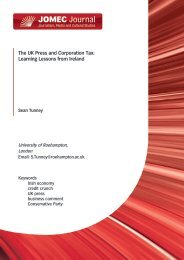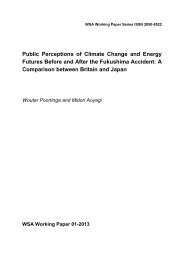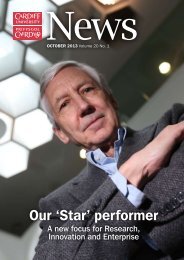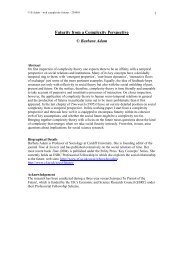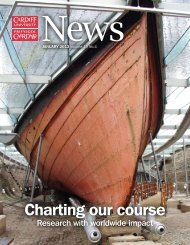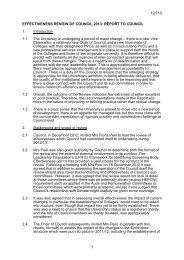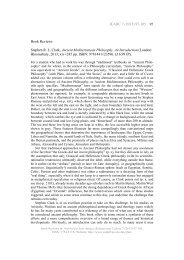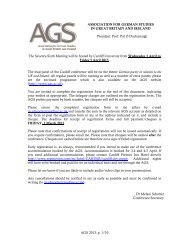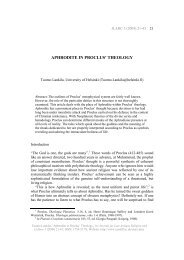Tina Askanius - Cardiff University
Tina Askanius - Cardiff University
Tina Askanius - Cardiff University
Create successful ePaper yourself
Turn your PDF publications into a flip-book with our unique Google optimized e-Paper software.
‘citizen reportage’, to signal how ordinary<br />
citizens (non-activists) increasingly<br />
engage in video documentation that<br />
stands out, not for technical or aesthetic<br />
proficiency, but for its sense of<br />
participation in audio-visual immediacy<br />
(Chanan 2011: 220). Critical to this genre<br />
is the sense of the presence of the<br />
person recording the video (Chanan<br />
2011: 222). Often the videographer’s<br />
voice (or cry) as she react to what is<br />
witnessed is present and forms part of<br />
the power of the message that comes<br />
across. Variations of the witness video<br />
also include follow-up interviews with<br />
activists providing eyewitness accounts<br />
recorded in the aftermath of the protests<br />
e.g. to counter mass media’s framing of<br />
the events. Videos such as the amateur<br />
studio interviews produced by Indymedia<br />
providing alternative eyewitness<br />
accounts of the death of Ian Tomlinson<br />
during the G20 protests in London fall<br />
under this category (see appendix 6).<br />
Documentation videos<br />
Documentation videos make up the body<br />
of videos that, in a simple and<br />
straightforward manner, document<br />
activist marches, speeches, community<br />
meetings, direct actions, political<br />
happenings etc. This cluster of selfdocumentation<br />
works mainly as modes<br />
of auto-communication and reflects the<br />
role of video in forging collective identity,<br />
a sense of belonging, community and<br />
sustained commitment. Examples<br />
include videos documenting the People’s<br />
Assembly during the COP 15 (see<br />
appendix 7) or the work of feminist<br />
collective FemFokus who try to capture<br />
the collective atmosphere of the<br />
ESF2008 while documenting the various<br />
political happenings around the city of<br />
Malmö during the social forum (see<br />
appendix 8). In a recent study of the use<br />
www.cf.ac.uk/JOMECjournal<br />
of YouTube by London-based social<br />
movement organisations, the author<br />
finds that ‘members use online spaces<br />
as visual archives of their offline activities<br />
and personal ties’, indicating how ‘photos<br />
from offline events can help sustain<br />
commitment to the group by providing<br />
group members with possibilities for<br />
viewing documentation from their own<br />
participation’ (Uldam 2010: 312). For<br />
these purposes, YouTube works as a<br />
cultural archive for offline activities<br />
forming a place of memory that fosters<br />
commitment to the act of participation<br />
(Carpentier 2010). Here we might also<br />
situate the longer video items that have<br />
sprung up recently in connection with<br />
the wave of occupied campuses and<br />
public spaces seized by activists in the<br />
Occupy movement, for example in<br />
London. Featuring the talks of supportive<br />
academics and writers such as Graeme<br />
Turner, Judith Butler or David Harvey<br />
visiting the protest camps, these videos<br />
are strongly reminiscent of what in the<br />
1960s was dubbed the ‘teach-in’<br />
(Chanan 2011). Other examples include<br />
the videos documenting the speeches of<br />
activist academics such as Naomi Klein<br />
at the alternative climate summit<br />
‘Klimaforum09’ in Copenhagen or the<br />
talk of Michael Hardt at the ESF in<br />
Malmö 2008 (see appendices 9 and 10).<br />
Archived radical video<br />
YouTube is also a space in which the<br />
digitised 16mm and 8mm film of<br />
historical video collectives are<br />
remediated so as to (potentially) bring<br />
new life and a new audience to these<br />
works. With a para-text or on-screen text<br />
presenting and contextualising the video<br />
for a present day audience, videos from<br />
historical Left-wing collectives such as<br />
7 <br />
@JOMECjournal



